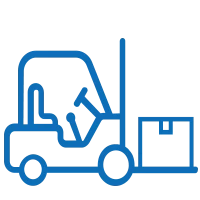Third-party logistics (3PL) companies are operating in a time of rapid change and high pressure. The size of the global logistics market was worth $8.4 trillion in 2021 and is expected to exceed over $13.7 trillion by 2027. So, what lies ahead for 2025 as the supply chain evolves? And how might it influence your forklift fleets and warehouse solutions?
The 3PL market in Europe, the Middle East, and Africa (EMEA) is projected to grow significantly over the next few years. By 2025, the market is expected to reach a value of approximately $0.43 trillion, driven by increasing demand, particularly in the e-commerce sector. With such growth at play, staying current with industry trends may help companies to remain competitive. Here, Yale Lift Truck Technologies explores some of the top trends affecting logistics warehouses.
1. The Rise of Micro-Fulfilment Centres (MFCs)
As e-commerce continues to grow, so does the demand for faster delivery. In recent years, this has disrupted the traditional 3PL model, with the birth of micro-fulfilment centres—small-scale, localised facilities - rather than only large, out of town logistics warehouses. From 2024 onwards, the European micro-fulfilment market is expected to grow by 33.8% each year to 2030.
Adding MFCs to a logistics network can help 3PLs to deliver the service their customers require, but it poses a different set of challenges to large warehouse sites. It presents a need for advanced materials handling technologies and solutions that can optimise space, support rapid order processing, and provide flexibility to the range of tasks needed to fulfil fast deliveries - 41% of global shoppers expect to receive goods within a day.
Compact warehouse technologies from Yale, such as Pallet Trucks and Pallet Stackers, can help maximise efficiency, while minimising the equipment footprint and keeping aisles narrow. To deal with variable demands, short term forklift rentals can also help keep the supply chain responsive.
2. Data-Driven Warehouse Optimisation
The Internet of Things (IoT) is transforming material handling by providing real-time visibility into operations, and the 3PL industry is no exception. Solutions, like Yale Vision telemetry, help businesses to monitor equipment performance, track inventory, and identify bottlenecks. This data-driven approach helps to improve operational efficiency and reduce downtime. For simplicity, the Yale Vision system can even be managed or accessed via an app.
Warehouse data can also be used to find solutions to the day-to-day challenges of 3PLs. For example, the Yale® Warehouse Simulator looks at different scenarios to help plan a 3PL warehouse configuration to improve efficient flowthrough and provide safeguards for unexpected operational challenges.
However, connectivity does not stop there when it comes to evolving the 3PL warehouse. Smart sensors are also working with forklifts to help get orders out the door on time, by mitigating potential hazards. Yale Reliant uses a combination of different sensors and technologies to help operators adhere to best practice. These smart systems limit truck performance and load handling functions, supporting 3PLs prioritising forklift accident prevention.
3. Technologies Tackle Labour Market Challenges
Labour shortages continue to challenge third party logistics operations. Warehouses typically face the strain of a 37% employee churn rate. For some 3PLs, automation is a critical tool for alleviating labour pressures. It can reduce reliance on manual labour, while helping optimise workflows and supporting continuity.
Warehouses and distribution centres are increasingly adopting a range of automated and robotic solutions, such as automated guided vehicles (AGVs), autonomous mobile robots (AMRs), and robotic arms for tasks like picking, packing, and palletising.
However, automation is not the only solution to the labour crisis. Operator Assistance Systems, ergonomic design, and flexible equipment all provide practical solutions that support human operators and can help encourage both efficiency and staff retention. Find out more in this Yale whitepaper: Beyond robotics: Why automation isn’t the only solution to warehouse labour shortages.
Advice for 3PL warehouses
Talk to your Yale dealer for local insight and advice on the Yale solutions that could help your third-party logistics operation turn the latest trends into opportunities.


